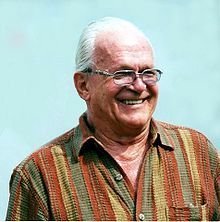
An engagement ring, also known as a betrothal ring, is a ring indicating that the person wearing it is engaged to be married, especially in Western cultures. A ring is presented as an engagement gift by a partner to their prospective spouse when they propose marriage or directly after a marriage proposal is accepted. It represents a formal agreement to future marriage. In most Western countries, engagement rings are worn mostly by women, and rings can feature diamonds or other gemstones. The neologism "mangagement ring" is sometimes used for an engagement ring worn by men. In some cultures, including Northern Europe, both partners wear matching rings, and engagement rings may also be used as wedding rings. In the Anglosphere, the ring is customarily worn on the left hand ring finger, but customs vary considerably elsewhere across the world.
Historically, engagement rings are blessed and then worn during the betrothal ceremony of a couple, but neither the engagement ring nor any other ring is worn at the time when the wedding ring is put by the groom on the finger of the bride as part of the marriage ceremony, and sometimes by the bride onto the groom's finger. After the wedding, the engagement ring is usually put back on and is usually worn on the outside of the wedding ring. In the present-day, the giving of the engagement ring "constitutes the subarrhatio".
Although the ancient Egyptians are sometimes credited with inventing the engagement ring, and the ancient Greeks with adopting the tradition, the history of the engagement ring can only be reliably traced as far back as ancient Rome.
In many countries, engagement rings are placed on the ring finger of the left hand. At one time it was believed that this finger contained a vein (the vena amoris) that led to the heart. This idea was popularized by Henry Swinburne in A treatise of Spousals, or Matrimonial Contracts (1686). The story seems to have its origin in the ancient Roman book Attic Nights by Aulus Gellius quoting Apion's Aegyptiacorum, where the alleged vein was originally a nervus (a word that can be translated either as "nerve" or "sinew").
The popular belief that an engagement ring was originally part of the bride price which represented purchase and ownership of the bride, has been called into question by contemporary scholarship.
In the second century BC, the Roman bride-to-be was given two rings, a gold one which she wore in public, and one made of iron which she wore at home while attending to household duties. At one time Roman citizens wore rings made of iron. In later years senators who served as ambassadors were given gold seal rings for official use when abroad. Later the privilege of wearing gold rings was extended to other public officials, then to the knights, later to all freeborn, and finally under Justinian, to freedmen. For several centuries it was the custom for Romans to wear iron rings at home, gold rings in public. During this period a girl or woman might receive two engagement rings, one of iron and one of gold.
20th century
In the United States, the popularity of diamond engagement rings declined after World War I, even more so than after the onset of the Great Depression.
In 1938, the diamond cartel De Beers began a marketing campaign that would have a major impact on engagement rings. During the Great Depression of the 1930s, the price of diamonds collapsed. At the same time, market research indicated that engagement rings were going out of style with the younger generation. Before World War II, only 10% of American engagement rings contained a diamond. While the first phase of the marketing campaign consisted of market research, the advertising phase began in 1939. One of the first elements of this campaign was to educate the public about the 4 Cs (cut, carats, color, and clarity). In 1947 the slogan "a diamond is forever" was introduced. Ultimately, the De Beers campaign sought to persuade the consumer that an engagement ring is indispensable, and that a diamond is the only acceptable stone for an engagement ring. The sales of diamonds in the United States rose from $23 million to $2.1 billion between 1939 and 1979.
Law professor Margart F. Brining links the surge in engagement ring sales in the USA after 1945 to the abolishment of the "breach of promise", that had entitled a woman whose fiancé had broken off their engagement to sue him for damages. This rule of law was especially important for many women who had been sexually intimate with the fiance, but were socially expected to be virgins in a new marriage, therefore lost "market value". After the gradual abolishment of that law action in all states the expensive engagement ring rose to popularity as a new financial security in case of a break-up, since it was custom for the women to keep the ring (partly only under the condition that the break-up was not seen as her fault).
21st century
In the early 21st century, the jewelry industry started marketing engagement rings for men under the name "management rings".
Bacon Guacamole Deviled Eggs
6 eggs, boiled, cooled, peeled, and cut in half
- 1 large avocado, mashed
- 2 tablespoons bacon, cooked and crumbled
- 1 tablespoon jalapeno, finely diced
- 1 tablespoon red onion, finely diced
- 2 tablespoons diced tomato
- 1 tablespoon lime juice (~1/2 lime)
- 1 tablespoon cilantro, chopped
- salt, pepper and cayenne to taste
- pinch chili powder (for garnish)
Directions
- Scoop the yolks out of the egg halves, mash them, mix with the avocado, bacon, jalapeno, onion, tomato, lime juice and cilantro and season with salt, pepper and cayenne.
- Place a tablespoon of the mixture back into the holes left by the yolks in the eggs and serve garnished with extra bacon and a pinch of chili powder.
On February 1st, National Dark Chocolate Day reminds us to indulge a little. Many tout dark chocolate as the healthier chocolate. However, for some, it can be an acquired taste.
Also known as bittersweet chocolate, dark chocolate is different from milk chocolate. Candy makers add milk or butter to milk chocolate, giving it a creamier consistency. Dark chocolate includes no added milk or butter. Instead, the percentage of cocoa solids remaining in the chocolate determines how dark the chocolate is. The higher the ratio, the darker the chocolate. It may also have a slightly bitter taste.
Chocolate comes from the seed of the tropical Theobroma cacao tree. We have been cultivating cacao for at least three millennia, and the plant grows in Mexico, Central America, and Northern South America. Our earliest known documentation of using cacao seeds dates to around 1100 BC.
Fermentation helps develop the flavor of the cacao seeds. Otherwise, the seeds are too bitter to eat. Once fermented, the beans are dried, cleaned, and roasted. After roasting, the shell is removed to produce cacao nibs. Processors then ground the cocoa nips into cocoa mass, pure chocolate in rough form. Next, they usually liquefy the cocoa mass and mold it with or without other ingredients. At this point in the process, it is called chocolate liquor. The chocolate liquor may then be processed into two components: cocoa solids and cocoa butter.
Besides being lower in calories and fat, dark chocolate has many other health benefits. It also serves as a decadent ingredient in many desserts and sauces.











